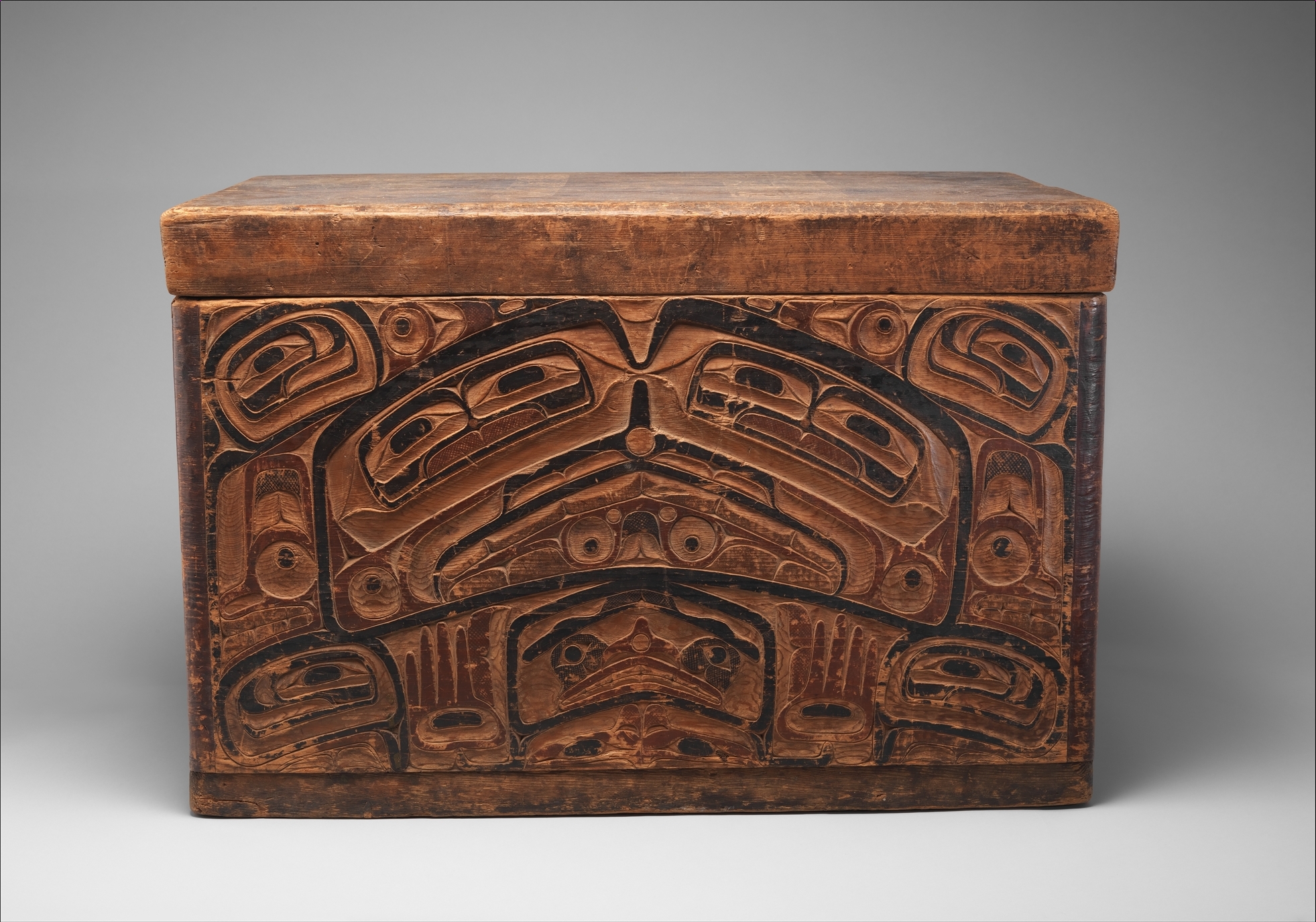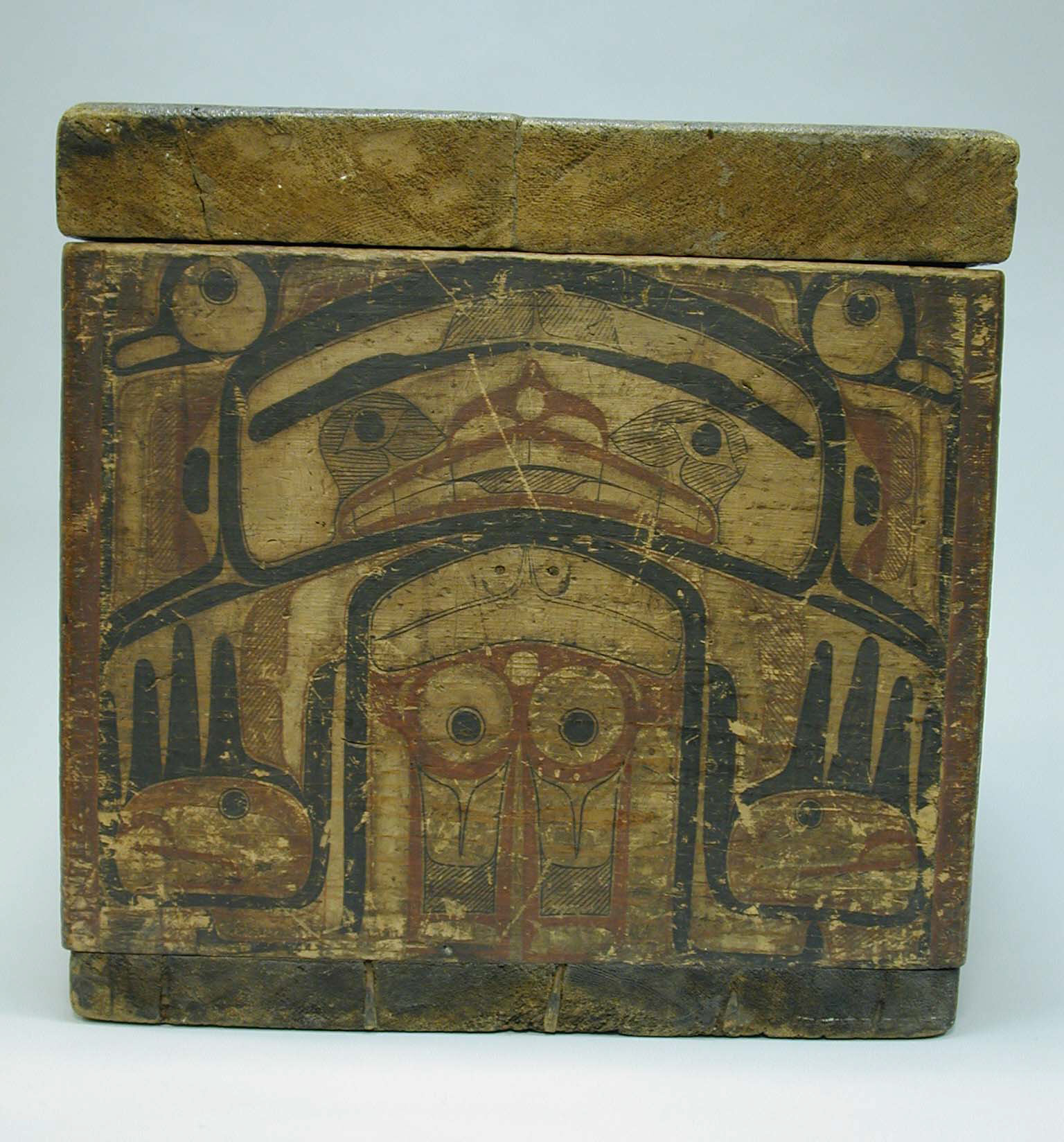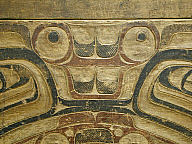Storage Chest
Not on view
This elaborate cedar storage chest was made by Tlingit artists from the southeast region of Alaska in the late 19th century. The chest is composed of three parts: a bent panel for the sides, a thin flat base, and a thick closing lid that fits securely over the exterior frame. The four vertical walls are made from a single plank of wood that has been scored, steamed, and bent into shape using a kerfing technique. The front- and back-facing designs of this chest were first carved in shallow relief and then painted; the lateral faces of the container feature painted designs with no carved relief. On the front of the chest, a broad, frontal face with bared teeth and tongue is indicated in black outline. The abstracted face has two double-eyes and elaborations of faces located in the inner eye sockets. Its tongue hangs from a gaping mouth, split into two rounded ovoids. Underneath the face, a human form emerges, positioned between two upright hands painted in red. Salmon-trout-head ovoids are placed as space fillers at each of the four corners. These small ovular forms and rounded ovoids are echoed throughout the copiously decorated surface. The lateral sides of the container are each embellished with a painted elongated figure with two upright hands. Select features of the figure are further emphasized by fine hatching.
This type of ornamented storage chest performed visual, social, and utilitarian functions within the Tlingit community, and served as symbols of economic and symbolic power. The creature on the front of the chest represents the shape-shifting sea monster Gonakadet, the Chief of Wealth, described in the oral traditions of the Tlingit (McLennan and Duffek 2000: 129). The act of painting and carving the creature’s image is believed to invoke the spirit to dwell within the chest and guard its valuable contents, as well as assign value to the container as a symbol of social rank and wealth (Stewart 1984: 87).
Highly embellished chests, such as this one, were used to house clan treasures and ceremonial regalia including dance robes, blankets, furs, masks, rattles, drums, copper items, and other paraphernalia. These cherished belongings were removed and used for special occasions such as dances, feasts, and other important communal celebrations. Storage boxes would also play an important role in the distribution of chiefly regalia. Finely crafted containers functioned as a form of property traded during a potlach, a large ceremonial feast and gift-giving tradition hosted by a chief during the winter months to redistribute the wealth among community members and invited guests. On certain occasions, chests and their contents were set out on display to affirm the wealth and status of a household. The distribution of, and occasionally, destruction of, lavish gifts and possessions in ceremonial practice is meant to uphold the host’s social rank and prestige. Such ceremonial feasts highlight the importance of distribution and gift-exchange among the indigenous peoples of the Pacific Northwest Coast region, and the key role finely crafted works played in community identity and ritual practice.
Gabriella Wellons, Museum Seminar Intern, 2019
References
Holm, Bill. Northwest Coast Indian Art: An Analysis of Form. Seattle: University of Washington Press, 1962.
Jonaitis, Aldona. Art of the Northwest Coast. Seattle: University of Washington Press, 2006.
Jonaitis, Aldona. Art of the Northern Tlingit. Seattle: University of Washington Press, 1986.
McLennan, Bill and Karen Duffek. The Transforming Image: Painted Arts of Northwest Coast First Nations. Seattle: University of Washington Press, 2000.
Stewart, Hilary. Cedar: Tree of Life to the Northwest Coast Indians. Vancouver, B.C.: Douglas & McIntyre, 1984.
Sturtevant, William C. Boxes and Bowls: Decorated Containers by Nineteenth-Century Haida, Tlingit, Bella Bella, and Tsimshian Indian Artists. Published for the Renwick Gallery by Smithsonian Institution Press, 1974.
Due to rights restrictions, this image cannot be enlarged, viewed at full screen, or downloaded.
This artwork is meant to be viewed from right to left. Scroll left to view more.








